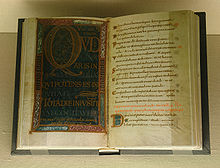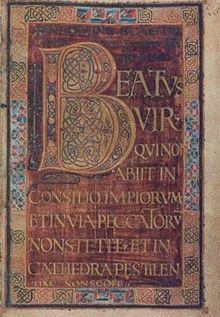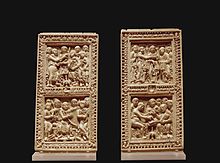
Pope Adrian I was the bishop of Rome and ruler of the Papal States from 1 February 772 to his death. He was the son of Theodore, a Roman nobleman.

The Vulgate, sometimes referred to as the Latin Vulgate, is a late-4th-century Latin translation of the Bible.
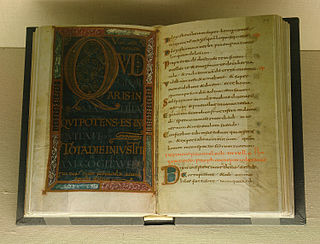
A psalter is a volume containing the Book of Psalms, often with other devotional material bound in as well, such as a liturgical calendar and litany of the Saints. Until the emergence of the book of hours in the Late Middle Ages, psalters were the books most widely owned by wealthy lay persons. They were commonly used for learning to read. Many Psalters were richly illuminated, and they include some of the most spectacular surviving examples of medieval book art.

The Melisende Psalter is an illuminated manuscript commissioned around 1135 in the crusader Kingdom of Jerusalem, probably by Fulk, King of Jerusalem for his wife Queen Melisende. It is a notable example of Crusader art, which resulted from a merging of the artistic styles of Roman Catholic Europe, the Eastern Orthodox Byzantine Empire and the art of the Armenian illuminated manuscript.

The Codex Amiatinus is considered the best-preserved manuscript of the Latin Vulgate version of the Christian Bible. It was produced around 700 in the northeast of England, at the Benedictine Monkwearmouth–Jarrow Abbey in the Kingdom of Northumbria, now South Tyneside, and taken to Italy as a gift for Pope Gregory II in 716. It was one of three giant single-volume Bibles then made at Monkwearmouth–Jarrow, and is the earliest complete one-volume Latin Bible to survive, only the León palimpsest being older; and the oldest Bible where all the biblical canon present what would be their Vulgate texts.
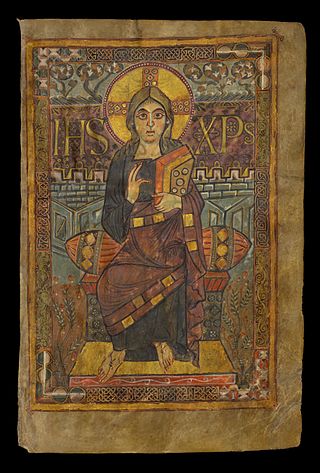
The Godescalc Evangelistary, Godescalc Sacramentary, Godescalc Gospels, or Godescalc Gospel Lectionary is an illuminated manuscript in Latin made by the Frankish scribe Godescalc and today kept in the Bibliothèque nationale de France. It was commissioned by the Carolingian king Charlemagne and his wife Hildegard on October 7, 781 and completed on April 30, 783. The Evangelistary is the earliest known manuscript produced at the scriptorium in Charlemagne's Court School in Aachen. The manuscript was intended to commemorate Charlemagne's march to Italy, his meeting with Pope Adrian I, and the baptism of his son Pepin. The crediting of the work to Godescalc and the details of Charlemagne's march are contained in the manuscript's dedication poem.

The Vespasian Psalter is an Anglo-Saxon illuminated psalter decorated in a partly Insular style produced in the second or third quarter of the 8th century. It contains an interlinear gloss in Old English which is the oldest extant English translation of any portion of the Bible. It was produced in southern England, perhaps in St. Augustine's Abbey or Christ Church, Canterbury or Minster-in-Thanet, and is the earliest illuminated manuscript produced in "Southumbria" to survive.

Lorsch Abbey, otherwise the Imperial Abbey of Lorsch, is a former Imperial abbey in Lorsch, Germany, about 10 km (6.2 mi) east of Worms. It was one of the most renowned monasteries of the Carolingian Empire. Even in its ruined state, its remains are among the most important pre-Romanesque–Carolingian style buildings in Germany. Its chronicle, entered in the Lorscher Codex compiled in the 1170s, is a fundamental document for early medieval German history. Another famous document from the monastic library is the Codex Aureus of Lorsch. In 1991 the ruined abbey was listed as a UNESCO World Heritage Site because of its architectural and historical importance.

Carolingian art comes from the Frankish Empire in the period of roughly 120 years from about 780 to 900—during the reign of Charlemagne and his immediate heirs—popularly known as the Carolingian Renaissance. The art was produced by and for the court circle and a group of important monasteries under Imperial patronage; survivals from outside this charmed circle show a considerable drop in quality of workmanship and sophistication of design. The art was produced in several centres in what are now France, Germany, Austria, northern Italy and the Low Countries, and received considerable influence, via continental mission centres, from the Insular art of the British Isles, as well as a number of Byzantine artists who appear to have been resident in Carolingian centres.

Ottonian art is a style in pre-romanesque German art, covering also some works from the Low Countries, northern Italy and eastern France. It was named by the art historian Hubert Janitschek after the Ottonian dynasty which ruled Germany and Northern Italy between 919 and 1024 under the kings Henry I, Otto I, Otto II, Otto III and Henry II. With Ottonian architecture, it is a key component of the Ottonian Renaissance. However, the style neither began nor ended to neatly coincide with the rule of the dynasty. It emerged some decades into their rule and persisted past the Ottonian emperors into the reigns of the early Salian dynasty, which lacks an artistic "style label" of its own. In the traditional scheme of art history, Ottonian art follows Carolingian art and precedes Romanesque art, though the transitions at both ends of the period are gradual rather than sudden. Like the former and unlike the latter, it was very largely a style restricted to a few of the small cities of the period, and important monasteries, as well as the court circles of the emperor and his leading vassals.

The Paris Psalter is a Byzantine illuminated manuscript, 38 x 26.5 cm in size, containing 449 folios and 14 full-page miniatures. The Paris Psalter is considered a key monument of the so-called Macedonian Renaissance, a 10th-century renewal of interest in classical art closely identified with the emperor Constantine VII Porphyrogenitus (909-959) and his immediate successors.
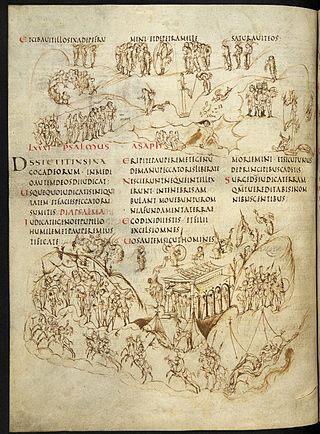
The Utrecht Psalter is a ninth-century illuminated psalter which is a key masterpiece of Carolingian art; it is probably the most valuable manuscript in the Netherlands. It is famous for its 166 lively pen illustrations, with one accompanying each psalm and the other texts in the manuscript. The precise purpose of these illustrations, and the extent of their dependence on earlier models, have been matters of art-historical controversy. The psalter spent the period between about 1000 to 1640 in England, where it had a profound influence on Anglo-Saxon art, giving rise to what is known as the "Utrecht style". It was copied at least three times in the Middle Ages. A complete facsimile edition of the psalter was made in 1875, and another in 1984 (Graz).

Theodulf of Orléans was a writer, poet and the Bishop of Orléans during the reign of Charlemagne and Louis the Pious. He was a key member of the Carolingian Renaissance and an important figure during the many reforms of the church under Charlemagne, as well as almost certainly the author of the Libri Carolini, "much the fullest statement of the Western attitude to representational art that has been left to us by the Middle Ages". He is mainly remembered for this and the survival of the private oratory or chapel made for his villa at Germigny-des-Prés, with a mosaic probably from about 806. In Bible manuscripts produced under his influence, the Book of Baruch and the Letter of Jeremiah became part of the Western (Vulgate) Bible canon.

The Libri Carolini, more correctly Opus Caroli regis contra synodum, is a work in four books composed on the command of Charlemagne in the mid 790s to refute the conclusions of the Byzantine Second Council of Nicaea (787), particularly as regards the matter of sacred images. They are "much the fullest statement of the Western attitude to representational art that has been left to us by the Middle Ages".

There exist a number of translations of the Book of Psalms into the Latin language. They are a resource used in the Liturgy of the Hours and other forms of the canonical hours in the Latin liturgical rites of the Catholic Church.

The Gospels of Otto III is considered a superb example of Ottonian art because of the scope, planning, and execution of the work. The book has 276 parchment pages and has twelve canon tables, a double page portrait of Otto III, portraits of the four evangelists, and 29 full page miniatures illustrating scenes from the New Testament. The cover is the original, with a tenth-century carved Byzantine ivory inlay representing the Dormition of the Virgin. Produced at the monastery at Reichenau Abbey in about 1000 CE, the manuscript is an example of the highest quality work that was produced over 150 years at the monastery.

The Annales laureshamenses, also called Annals of Lorsch (AL), are a set of Reichsannalen that cover the years from 703 to 803, with a brief prologue. The annals begin where the "Chronica minora" of the Anglo-Saxon historian Bede leaves off—in the fifth year of the Emperor Tiberios III—and may have originally been composed as a continuation of Bede. The annals for the years up to 785 were written at the Abbey of Lorsch, but are dependent on earlier sources. Those for the years from 785 onward form an independent source and provide especially important coverage of the imperial coronation of Charlemagne in 800. The Annales laureshamenses have been translated into English.

The Eadwine Psalter or Eadwin Psalter is a heavily illuminated 12th-century psalter named after the scribe Eadwine, a monk of Christ Church, Canterbury, who was perhaps the "project manager" for the large and exceptional book. The manuscript belongs to Trinity College, Cambridge and is kept in the Wren Library. It contains the Book of Psalms in three languages: three versions in Latin, with Old English and Anglo-Norman translations, and has been called the most ambitious manuscript produced in England in the twelfth century. As far as the images are concerned, most of the book is an adapted copy, using a more contemporary style, of the Carolingian Utrecht Psalter, which was at Canterbury for a period in the Middle Ages. There is also a very famous full-page miniature showing Eadwine at work, which is highly unusual and possibly a self-portrait.
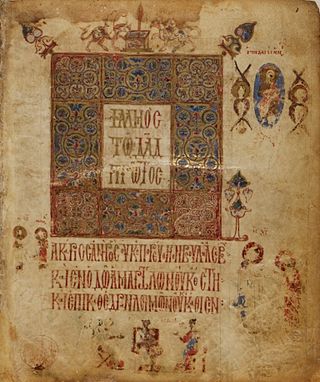
The Theodore Psalter is an illustrated manuscript and compilation of the Psalms and the canticles, or Odes from the Old Testament. "This Psalter has been held in the British Library since 1853 as Additional 19.352," wrote Princeton Art History professor Charles Barber in his first essay that is a companion to the Theodore Psalter E-Facsimile. Barber called the Psalter, "One of the richest illuminated manuscripts to survive from Byzantium."

The Psalter of Charlemagne is an 8th-century Latin manuscript containing the Gallican Psalter with litanies, collects and a tonary.
